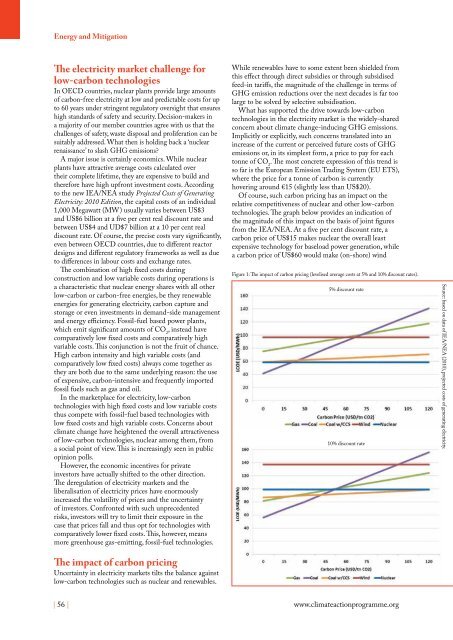Climate Action 2010-2011
Create successful ePaper yourself
Turn your PDF publications into a flip-book with our unique Google optimized e-Paper software.
Energy and Mitigation<br />
The electricity market challenge for<br />
low-carbon technologies<br />
In OECD countries, nuclear plants provide large amounts<br />
of carbon-free electricity at low and predictable costs for up<br />
to 60 years under stringent regulatory oversight that ensures<br />
high standards of safety and security. Decision-makers in<br />
a majority of our member countries agree with us that the<br />
challenges of safety, waste disposal and proliferation can be<br />
suitably addressed. What then is holding back a ‘nuclear<br />
renaissance’ to slash GHG emissions?<br />
A major issue is certainly economics. While nuclear<br />
plants have attractive average costs calculated over<br />
their complete lifetime, they are expensive to build and<br />
therefore have high upfront investment costs. According<br />
to the new IEA/NEA study Projected Costs of Generating<br />
Electricity: <strong>2010</strong> Edition, the capital costs of an individual<br />
1,000 Megawatt (MW) usually varies between US$3<br />
and US$6 billion at a five per cent real discount rate and<br />
between US$4 and UD$7 billion at a 10 per cent real<br />
discount rate. Of course, the precise costs vary significantly,<br />
even between OECD countries, due to different reactor<br />
designs and different regulatory frameworks as well as due<br />
to differences in labour costs and exchange rates.<br />
The combination of high fixed costs during<br />
construction and low variable costs during operations is<br />
a characteristic that nuclear energy shares with all other<br />
low-carbon or carbon-free energies, be they renewable<br />
energies for generating electricity, carbon capture and<br />
storage or even investments in demand-side management<br />
and energy efficiency. Fossil-fuel based power plants,<br />
which emit significant amounts of CO 2<br />
, instead have<br />
comparatively low fixed costs and comparatively high<br />
variable costs. This conjunction is not the fruit of chance.<br />
High carbon intensity and high variable costs (and<br />
comparatively low fixed costs) always come together as<br />
they are both due to the same underlying reason: the use<br />
of expensive, carbon-intensive and frequently imported<br />
fossil fuels such as gas and oil.<br />
In the marketplace for electricity, low-carbon<br />
technologies with high fixed costs and low variable costs<br />
thus compete with fossil-fuel based technologies with<br />
low fixed costs and high variable costs. Concerns about<br />
climate change have heightened the overall attractiveness<br />
of low-carbon technologies, nuclear among them, from<br />
a social point of view. This is increasingly seen in public<br />
opinion polls.<br />
However, the economic incentives for private<br />
investors have actually shifted to the other direction.<br />
The deregulation of electricity markets and the<br />
liberalisation of electricity prices have enormously<br />
increased the volatility of prices and the uncertainty<br />
of investors. Confronted with such unprecedented<br />
risks, investors will try to limit their exposure in the<br />
case that prices fall and thus opt for technologies with<br />
comparatively lower fixed costs. This, however, means<br />
more greenhouse gas-emitting, fossil-fuel technologies.<br />
The impact of carbon pricing<br />
Uncertainty in electricity markets tilts the balance against<br />
low-carbon technologies such as nuclear and renewables.<br />
While renewables have to some extent been shielded from<br />
this effect through direct subsidies or through subsidised<br />
feed-in tariffs, the magnitude of the challenge in terms of<br />
GHG emission reductions over the next decades is far too<br />
large to be solved by selective subsidisation.<br />
What has supported the drive towards low-carbon<br />
technologies in the electricity market is the widely-shared<br />
concern about climate change-inducing GHG emissions.<br />
Implicitly or explicitly, such concerns translated into an<br />
increase of the current or perceived future costs of GHG<br />
emissions or, in its simplest form, a price to pay for each<br />
tonne of CO 2<br />
. The most concrete expression of this trend is<br />
so far is the European Emission Trading System (EU ETS),<br />
where the price for a tonne of carbon is currently<br />
hovering around €15 (slightly less than US$20).<br />
Of course, such carbon pricing has an impact on the<br />
relative competitiveness of nuclear and other low-carbon<br />
technologies. The graph below provides an indication of<br />
the magnitude of this impact on the basis of joint figures<br />
from the IEA/NEA. At a five per cent discount rate, a<br />
carbon price of US$15 makes nuclear the overall least<br />
expensive technology for baseload power generation, while<br />
a carbon price of US$60 would make (on-shore) wind<br />
Figure 1: The impact of carbon pricing (levelised average costs at 5% and 10% discount rates).<br />
5% discount rate<br />
10% discount rate<br />
Source: based on data of IEA/NEA (<strong>2010</strong>), projected costs of generating electricity.<br />
| 56 |<br />
www.climateactionprogramme.org












